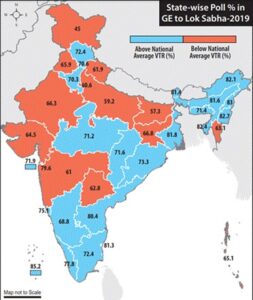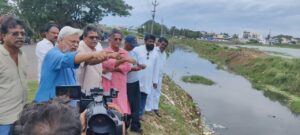
New Delhi: Bihar figured among the eleven States and Union Territories (UTs), that witnessed a voter turnout lower than the national average of 67.40% in the Lok Sabha elections of 2019.
 Moreover, out of the total 50 Rural Parliamentary Constituencies (PCs) across 11 States identified with lower voter turnout than the national average in 2019, 40 such PCs were in just two states – Bihar and Uttar Pradesh. 18 such constituencies were in Bihar with Uttar Pradesh leading the pack with 22 such PCs.
Moreover, out of the total 50 Rural Parliamentary Constituencies (PCs) across 11 States identified with lower voter turnout than the national average in 2019, 40 such PCs were in just two states – Bihar and Uttar Pradesh. 18 such constituencies were in Bihar with Uttar Pradesh leading the pack with 22 such PCs.
In Bihar, 29-Nalanda PC recorded the lowest turnout of 48.79% while 51-Phulpur PC in Uttar Pradesh recorded the lowest voter turnout of 48.79% in the 2019 general elections. The other states besides Bihar and Uttar Pradesh, which witnessed lower voter turnout than the national average in 2019 were Delhi, Maharashtra, Uttarakhand, Telangana, Gujarat, Punjab, Rajasthan, Jammu and Kashmir and Jharkhand.
It may be mentioned that approximately 297 million eligible voters did not vote in the General Elections to Lok Sabha in 2019 underscoring the scale of the problem which calls for proactive measures.
Of the 50 PCs with the lowest voter turnout in the 2019 General Elections to Lok Sabha, 17 were found to be in Metropolitans or major cities reflecting, in the words of the Election Commission of India (ECI), “an unfortunate trend of urban apathy”. The ECI noted that the same trend was seen in the past few State Assembly Elections. In the General Gujarat State Legislative Assembly elections 2022, Gandhidham Assembly Constituency (AC) in Kachchh district, which has industrial establishments, recorded the lowest polling percentage of 48.14%, a sharp decline of almost 6% than the last election in 2017, recording a new low. Similarly, in the Himachal Pradesh State Assembly Elections in 2022, the Shimla AC in the Shimla District (State Capital) recorded the lowest polling percentage of 63.48% against the State Average Poll % of 75.78%.
It was also observed in Surat that all rural Assembly Constituencies voted more in percentage terms than urban Assembly Constituencies of the district. The difference between the lowest urban AC of Surat and the highest rural AC was as much as 25%. Similarly, in the State Legislative Assembly Election of Karnataka 2023, AC Bommanahalli in Bangalore (Bangalore South) recorded the lowest voter turnout of 47.5% as compared to the State Average voter turnout of 73.84%.
To meet the challenge of low voter turnout, the ECI held for the first ever time a ‘Conference on Low Voter Turnout’ at Nirvachan Sadan, here today. In the day-long conference, Municipal Commissioners (MCs) from major cities and select District Election Officers (DEOs) from Bihar and Uttar Pradesh deliberated together to chart a path towards enhancing voter engagement and participation in identified urban and rural PCs. The Conference was chaired by Chief Election Commissioner (CEC) Rajiv Kumar along with Election Commissioners Gyanesh Kumar and Sukhbir Singh Sandhu. On the occasion, a booklet on voter apathy was released by the Commission.
The CEC said that a total of 266 Parliamentary Constituencies (215 Rural & 51 Urban) with low voter turnout have been identified and all concerned Municipal Commissioners, DEOs and State CEOs have been told to find ways to reach out to voters in a targeted manner.
CEC Kumar directed them to prepare a booth-wise action plan for enhanced participation and behaviour change. He asked all MCs and DEOs to prepare different strategies for urban and rural areas and plan interventions accordingly for different target audiences. He emphasized that the “One size fits all” approach will not yield results. He emphasized a three-pronged strategy of providing facilitation at polling stations like queue management, shelter parking in congested areas; targeted outreach and communication; and involvement of critical stakeholders like Resident Welfare Associations, local icons and youth influencers to persuade people to come to polling stations.
Kumar called for a movement in which people are self-motivated to vote. The ECI claimed it has implemented “a suite of initiatives aimed at reinvigorating voter engagement and participation, including:
- Devising a Turnout Implementation Plan (TIP) for targeted interventions at 266 urban and rural PCs.
- Crafting district-specific themes for polling stations catering to diverse demographic groups.
- Collaborating with key stakeholders to expand voter outreach and awareness efforts.
- Formalizing electoral literacy in the education system through strategic partnerships.
- Engaging National Icons to connect with and inspire young voters.
- Launching integrated multimedia campaigns and targeted initiatives like #MeraVoteDeshkeLiye.
- Ensuring updated electoral rolls and accessibility-friendly infrastructure at polling stations.
- Promoting the use of IT applications for enhanced citizen participation and transparency.
- Providing continuous training to election officials for the seamless conduct of elections.”
– global bihari bureau








